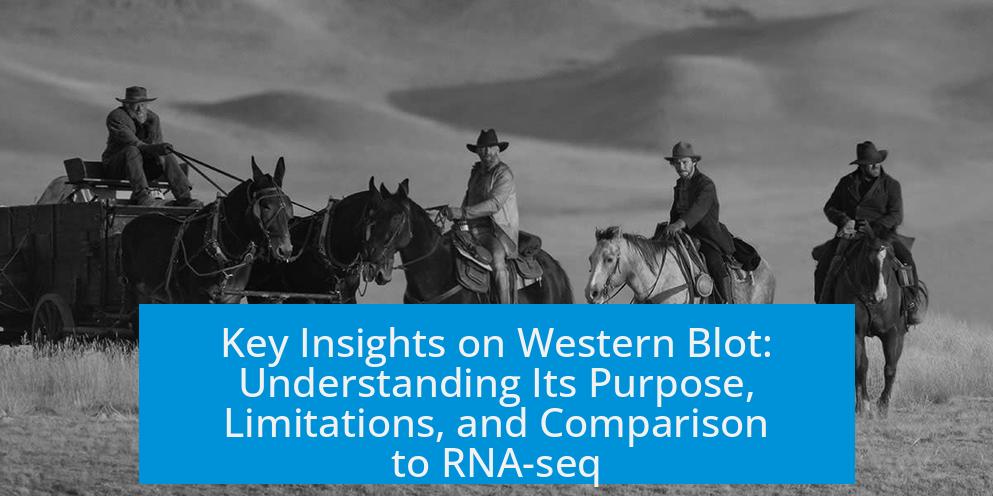Understanding the Western Blot: Answering Key Questions
 A Western blot is a technique used to detect specific proteins in a sample, measuring both their abundance and molecular weight. It is a qualitative, hypothesis-driven experiment widely used to assess differences in protein expression, especially useful in identifying protein variations such as splice variants. While Western blot provides direct evidence of protein presence and size, RNA-seq measures transcription levels, making Western blot superior for protein-level analysis.
A Western blot is a technique used to detect specific proteins in a sample, measuring both their abundance and molecular weight. It is a qualitative, hypothesis-driven experiment widely used to assess differences in protein expression, especially useful in identifying protein variations such as splice variants. While Western blot provides direct evidence of protein presence and size, RNA-seq measures transcription levels, making Western blot superior for protein-level analysis.
What Is Western Blot and What Does It Measure?
Western blot is a laboratory method designed to detect and analyze proteins. It involves protein separation by gel electrophoresis, transfer to a membrane, and probing with antibodies specific to the protein of interest. This allows researchers to determine not only how much of a protein is present but also its molecular weight.
Western blot is particularly effective for identifying protein variants that differ in size due to alternative splicing or mutations. For example, splice variants producing truncated proteins show distinct bands in a Western blot, unlike RNA-based techniques that only capture transcripts.
Key Characteristics of Western Blot
- Detects protein abundance and size directly
- Effective for confirming the presence of splice variants
- Qualitative—shows presence or absence rather than precise quantity
- Requires specific antibodies for each target protein
How Does Western Blot Compare to RNA-seq?
RNA sequencing (RNA-seq) profiles RNA transcripts in a sample, revealing gene expression patterns with broad scope. However, RNA levels often do not correlate well with protein levels due to post-transcriptional regulation, translation efficiency, and protein degradation.
Western blot directly measures proteins, providing data more relevant to functional cellular processes. RNA-seq is better suited for surveying global transcriptional changes but does not reliably indicate how much protein is produced.
| Feature | Western Blot | RNA-seq |
|---|---|---|
| What it measures | Protein abundance and size | RNA transcript abundance and sequence |
| Quantitative ability | Qualitative/binary (presence/absence) | Quantitative (read counts) |
| Scope | Single or few proteins per assay | Transcriptome-wide, unbiased |
| Applications | Confirm protein expression; detect variant proteins | Assess gene expression; identify splice variants at RNA level |
Why Use Western Blot for Splice Variant Analysis?
Splice variants can produce protein isoforms differing in size or structure. Western blot enables visualization of these differences directly.
If a splice variant produces a truncated or altered protein, its distinct size appears as a unique band on the Western blot. This is critical for understanding how such variants impact protein function, especially in diseases involving structural protein changes.
RNA-seq might detect altered splice junctions at the RNA level, but the ultimate effect at the protein level is confirmed by Western blot.
Technical Differences and Practical Considerations
Western blots are generally quicker and more accessible. A typical Western blot runs within two days if antibodies are available and optimized. It is feasible within a standard laboratory.
In contrast, RNA-seq is costlier, requires sequencing machines, and involves complex bioinformatics. Data processing may take weeks and is often outsourced to core facilities.
Researchers often perform Western blot first because of its speed and direct protein readout. RNA-seq provides complementary information and helps in broad transcriptomic analysis.
Limitations of Western Blot
- Qualitative, not strictly quantitative
- Dependent on antibody specificity and quality
- Detects only target proteins specified by antibodies
- Can indicate “presence or absence” but not precise protein amounts
Because Western blots rely on suitable antibodies, results can be compromised by cross-reactivity or lack of sensitivity. Interpretation requires care, especially when assessing subtle changes.
Integrating Western Blot and RNA-seq for Complete Insight
Neither Western blot nor RNA-seq alone fully captures cellular complexity. For disease research, combining both techniques offers a fuller picture:
- RNA-seq reveals new splicing events and transcriptional changes globally.
- Western blot confirms the actual protein products and size changes.
- Together, they clarify how genetic variants affect gene expression and protein function.
Western Blot as a Hypothesis-Driven Experiment
Western blot requires prior knowledge of the target protein. Researchers decide which protein to probe based on hypotheses. Testing additional proteins requires planning separate assays.
This specificity is useful when investigating known candidates but limits discovery of unexpected changes.
Challenges in Detecting Splicing Errors and RNA Variants
Detecting RNA splice variants can be complicated by RNA degradation pathways targeting aberrant RNA forms. RT-PCR with primers near splice defect sites may offer better RNA-level detection.
Western blot bypasses this by detecting the actual protein product, providing complementary evidence.
Key Takeaways
- Western blot measures protein presence and size directly, providing qualitative data.
- It is superior to RNA-seq for assessing protein-level changes, especially splice variants.
- Western blot runs faster and in-house, while RNA-seq is broader but slower and costlier.
- Both techniques complement each other and are often needed for complete molecular understanding.
- Western blot is a targeted, hypothesis-driven assay requiring specific antibodies.
- Limitations include qualitative nature and dependency on antibody quality.
- Integration of RNA-seq and Western blot improves detection of splice variants and understanding of disease-related protein changes.
What makes Western blot better than RNA-seq for measuring protein levels?
Western blot directly measures protein presence and size, unlike RNA-seq which measures RNA levels. Protein levels do not always match RNA levels due to regulation or splicing. Western blot reveals actual protein abundance and molecular weight differences.
How can Western blot detect splice variant proteins?
Splice variants often produce proteins of different sizes. Western blot shows size differences immediately, making it useful to confirm truncated or altered protein products from splicing changes.
Why is Western blot considered qualitative rather than quantitative?
Western blot indicates if a protein is present or absent clearly. However, it does not accurately measure precise protein amounts. Antibody quality and signal strength affect results, so it’s mainly useful for presence/absence comparisons.
When should a researcher choose Western blot over RNA-seq?
Western blot is faster and can be done in-house with existing antibodies. It directly tests specific proteins. RNA-seq is more costly, slower, and provides broad RNA data but not direct protein levels.
Why are both Western blot and RNA-seq needed in studying gene expression?
RNA-seq shows RNA transcript variants and overall transcription changes, while Western blot confirms if these changes affect protein size or amount. Combining both gives a fuller picture of gene expression and function.





Leave a Comment